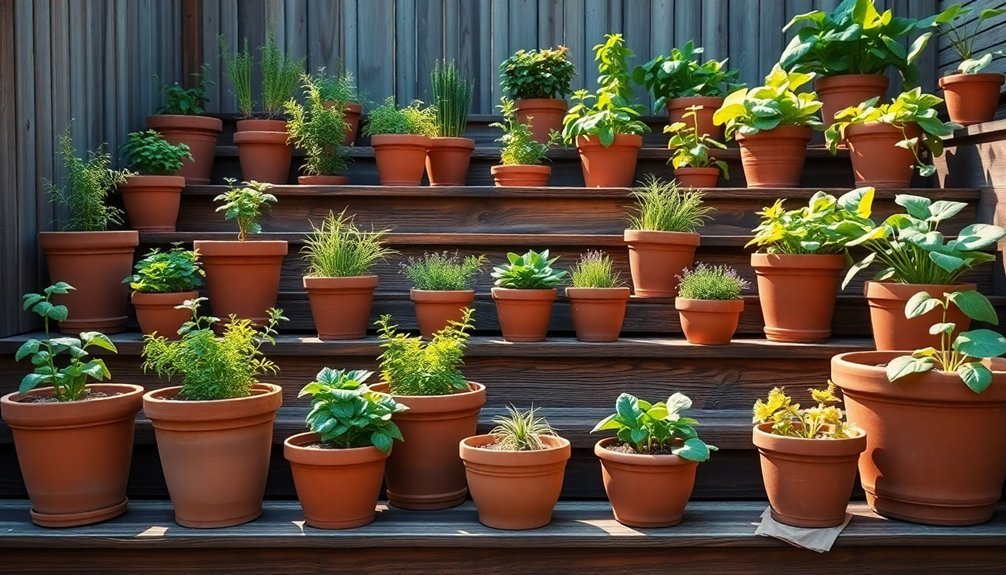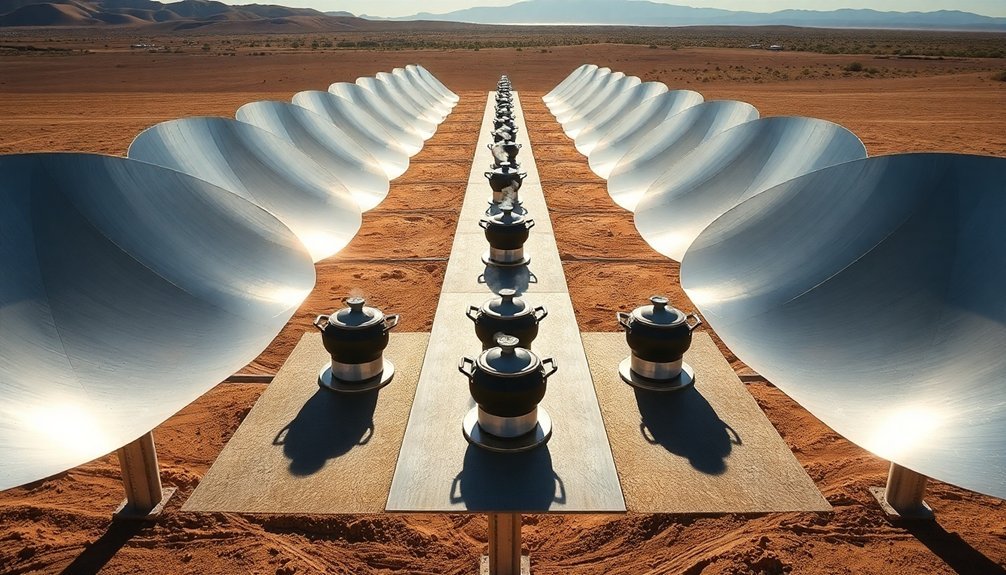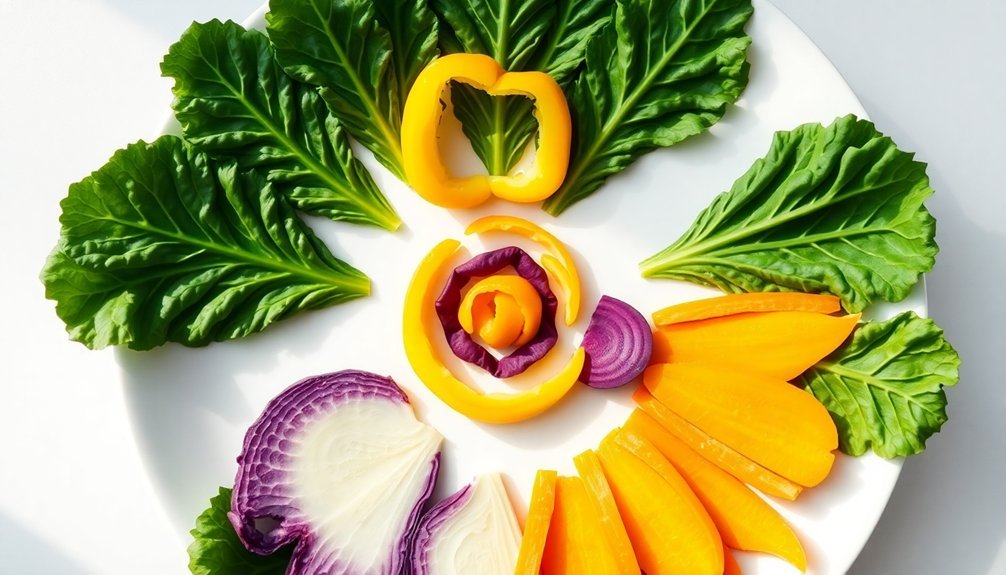Position your food arrangements strategically to maximize solar cooking power using seven proven layouts. You'll get the best results with a multi-tier reflector setup that curves to capture more sunlight, while circular heat zones with concentric rings optimize thermal collection. Stack your pots carefully with proper spacing for maximum sun exposure, and arrange dishes along temperature gradients to match cooking needs. You'll want to place high-temp items at reflector focal points and use dark containers in solar box cookers for better heat retention. With proper placement and the right container positioning, you'll reveal the full potential of solar cooking efficiency.
Multi-Tier Reflector Configuration Setup

When designing a multi-tier reflector system, curved reflectors prove superior to plane-type configurations due to their enhanced ability to capture sunlight across various angles.
You'll achieve better performance by incorporating curved reflectors that minimize sunlight loss, especially during summer months when sun elevation is high.
To maximize your system's efficiency, you'll want to arrange the curved reflectors in multiple tiers that accommodate seasonal changes in sun angles. This setup guarantees consistent energy capture throughout the year. The system's ability to achieve higher operating temperatures makes it more thermodynamically efficient than traditional solar thermal systems.
While Linear Fresnel Reflectors (LFRs) offer a cost-effective alternative using flat mirror strips, they're most effective in large-scale installations.
For ideal results, consider using silver-coated reflective surfaces, which provide superior UV reflection. Remember to protect these surfaces with appropriate glass substrates to maintain long-term performance and durability.
Circular Heat Zone Placement
As you design your solar heating system, proper circular heat zone placement becomes critical for maximizing thermal energy collection.
You'll need to position your thermal storage materials in concentric circles, with the most heat-intensive elements at the center where sunlight concentration is highest.
Start by ensuring your solar panels face south at a tilt matching your latitude (25-36° in Texas).
These south-facing installations will provide optimal daily exposure from sunrise to sunset.
You'll want to arrange your thermal mass materials, like masonry or water containers, in circular zones radiating outward from the central collection point.
For concentrated solar power systems, position your parabolic troughs to track the sun along a single axis, creating focused heat zones.
Don't forget to incorporate proper insulation between zones to maintain temperature gradients and maximize heat retention in your storage media.
Stacking Pots For Maximum Exposure

Building on the principles of circular heat zones, proper pot stacking creates an efficient vertical garden that maximizes sun exposure.
You'll need to guarantee each pot receives at least six hours of direct sunlight daily, with some plants requiring up to eight hours for ideal growth.
Select containers made from lightweight plastic materials for easier movement and arrangement when stacking your garden setup.
When you're stacking pots, install drainage holes to prevent water pooling and use black containers to enhance solar absorption.
You can stack them as high as you'd like, but remember to add riser pipes every 5-6 levels for stability. Support your structure with PVC pipes and steel poles for durability.
To maintain healthy growth, water your plants three times daily at 1-minute intervals, typically at 9am, 1pm, and 5pm.
If you're placing your setup near buildings or furniture, account for potential shade that might reduce sunlight exposure.
Temperature Gradient Dish Arrangement
The science of temperature gradient layouts transforms your solar cooking setup into a high-efficiency food preparation station. By understanding the sun's orientation and ideal angles, you'll want to arrange your dishes based on their required cooking temperatures.
Place your highest-temperature dishes where the focal point of your reflectors or concentrators is most intense, typically at a 15-degree incidence angle for maximum energy absorption. Using larger insolated areas will significantly boost your overall cooking power, even if temperatures remain constant.
You'll get better results by positioning larger pots with longer cooking times in areas with consistent solar exposure, while quick-cooking items can go in spots with less direct radiation.
Don't forget to use insulated containers or thermal masses beneath your cookware to maintain steady temperatures. If you're using parabolic reflectors, make sure each dish's position aligns with the concentrated solar rays for ideal heating efficiency.
Solar Box Cooker Layout

While maximizing solar cooking efficiency depends on multiple factors, proper layout of your box cooker serves as the foundation for successful solar cooking.
Position your cooker with an increased east-west dimension and align it directly facing the sun during peak hours.
Place dark-colored cooking vessels on the black-coated interior surface, and you'll want to arrange smaller pieces of food in sealed containers to prevent condensation.
Use thermal mass objects like bricks around your cooking vessels to store heat, and make sure your reflective lid is properly angled to direct sunlight onto the food.
For ideal heat retention, double-check that your glass cover fits tightly and all insulation materials are properly secured.
Don't forget to reposition your cooker every couple of hours to maintain direct sun exposure throughout the cooking process.
Parabolic Mirror Food Positioning
Moving from box cookers to parabolic designs introduces greater precision in food placement and temperature control.
You'll need to position your cooking vessel exactly at the focal point, typically 500mm along the support pipe for a 1-meter radius curve, where temperatures can exceed 350°F.
First, align your reflective surface with the sun's rays, keeping it clean and debris-free.
You can track the focal point by tracing the shadow of a pipe. Once you've identified this spot, secure your heat-resistant cooking vessel using a cross-formation support system made of threaded rod and steel bar.
Make sure it's stable enough to withstand wind and allow for easy adjustments as you track the sun's movement.
Remember to handle the setup carefully – the concentrated sunlight at the focal point can cause serious burns.
Linear Focus Cooking Pattern

Successfully arranging food in a linear focus pattern requires careful attention to composition and visual flow.
You'll want to position your protein between 3 and 9 o'clock, with starches from 9 to 12, and vegetables from 12 to 3. Using the rule of thirds, place your focal ingredient off-center while maintaining clean plate edges and proper white space.
- Use precision tools like pastry bags and squeeze bottles for accurate sauce placement
- Create visual interest with accent dots and artful sauce drizzles
- Position long, flat items against taller elements for dimension
- Add contrasting textures through garnishes like fried leeks
- Start with moist ingredients to prevent unwanted spreading
Remember to maintain balance throughout your composition while incorporating varied colors and textures.
This approach guarantees your sun-powered cooking achieves both ideal heating and stunning presentation.
Frequently Asked Questions
Can Reflective Mulch Increase Sunlight Exposure for Low-Growing Vegetables?
No, reflective mulch doesn't directly increase sunlight exposure for your low-growing vegetables. Instead, it reflects light back to the atmosphere while helping you manage soil temperature and deter pests for healthier plant growth.
How Do Different Colored Containers Affect Heat Absorption for Plants?
Dark containers will heat your plants excessively, while light-colored ones keep roots cooler. You'll see up to 50% more growth using white containers, as they absorb less heat than black ones do.
What's the Minimum Distance Needed Between Raised Beds for Optimal Sunlight?
You'll need at least 18-24 inches between raised beds, but consider your plants' height and shadows. Space them wider if you're growing tall crops or using trellises to prevent shading neighboring beds.
Do Climbing Plants on Trellises Block Too Much Sun for Plants Below?
You'll find climbing plants can shade lower plants, but you can minimize this by using open-design trellises, proper spacing, and regular pruning. Position sun-loving plants outside the trellis's shadow zone for best results.
Should Container Gardens Be Rearranged Seasonally to Maximize Sun Exposure?
Yes, you'll want to rearrange your container gardens seasonally. Moving your pots helps plants get ideal sunlight as the sun's path changes, ensuring healthy growth and preventing damage from too much exposure.
In Summary
You've now got the essential layouts to maximize solar cooking efficiency. With these seven strategic arrangements, you'll harness more sunlight and cook your meals faster. Whether you're using the multi-tier setup or parabolic mirror positioning, you'll save energy while creating delicious solar-cooked dishes. Try each configuration to find what works best for your climate and cooking style. Start experimenting today for better solar cooking results.





Leave a Reply